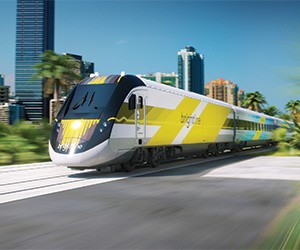Pardon me, boys, is that the Orange Blossom Special? It could be, if this was wintertime somewhere between 1925 and 1953, and you were traveling from New York’s Penn Station to the posh resorts of coastal Florida.
But long before this all-Pullman luxury train began escorting wealthy Northeasterners to the subtropics, Florida’s destiny as a premier vacation destination had already been sealed by the railroads, led by a group of enterprising moguls who saw beyond the acres of empty sawgrass prairies and swampland of early 19th century Florida and envisioned a leisure playground for sun-seeking vacationers.
The Railroad Barons
One of those early visionaries was a resourceful Florida senator named David Levy Yulee, who in 1851 fulfilled a long-standing ambition to connect Florida’s Atlantic coast to its Gulf of Mexico coast, pooling federal and state land grants to start construction on a rail line between Fernandina Beach and Cedar Key, and even moving the Fernandina town center to accommodate the coming train. Ten years later, after clearing dense jungle growth and laying track through mile after desolate mile, the first Florida Railroad train arrived in Cedar Key, inaugurating Florida’s first trans-state line.
Today in Fernandina Beach, set on the northern end of Amelia Island, Yulee’s statue—consulting its pocket watch for the next train—sits in front of the town’s old depot, which has been renovated and serves as a welcome center.
“You walk in and it has the look and feel of what was,” notes Amy Lacroix, director of marketing, advertising and meetings for the Amelia Island TDC. “They’re building on to it with a replica of what the train platform would have looked like.”
Not long after Yulee connected the Atlantic to the Gulf, Connecticut-born businessman Henry B. Plant was eyeing the southern railroad lines that had been crippled by the Civil War, and purchased two out of foreclosure in 1879 and 1880.
It was the beginning of an empire; 20 years later, Plant had started 14 railway companies, including a line that connected Sanford in Central Florida to Tampa Bay. Thanks to that connection, Tampa became a thriving port welcoming steamers and freighters from Cuba and South America, and the entire region opened up to citrus and vegetable growers. Henry Plant’s lavish Tampa Bay Hotel was charging rich Northerners $15 a night when the average price for a hotel in Tampa was about $1.50 a night.
Today, the Tampa Bay Hotel, now known as Plant Hall, is part of the University of Tampa and houses the Henry B. Plant Museum. Not only do the building’s dramatic minarets still dominate the downtown skyline, it’s still a center for events, with three ballrooms and lush grounds open to private functions.
But perhaps the most ambitious of all the railroad barons was Standard Oil magnate Henry Morrison Flagler, whose Florida East Coast Railway would eventually link the entire east coast of the state, including the first overseas railroad connection to Key West.
But in 1894, Flagler’s railroad terminated in Palm Beach, where he built the opulent Royal Poinciana Hotel, the fabled Breakers Hotel on the ocean, and Whitehall, his lavish winter home that lives on as the Flagler Museum, a National Historic Landmark featuring guided tours, changing exhibits and special programs. Private events here are held in Gilded Age style at the 4,800-square-foot Grand Hall, featuring a magnificent double staircase, or in the Flagler Kenan Pavilion overlooking Lake Worth.
Return by Train
As in the rest of the country, planes and automobiles had replaced trains as the primary mode of transportation by mid-century, though trains were still used for freight transport while their descendants—subways and commuter rail—remain indispensable to modern cities.
But train travel is set to make a comeback in Florida with the mid-2017 launch of Brightline by All Aboard Florida, a new intercity express train service that will initially run between Miami, Fort Lauderdale and West Palm Beach before continuing to Orlando by a still-unannounced date. Bypassing traffic and weather issues, Brightline’s travel times will leave cars behind—less than a half-hour from downtown Miami to downtown Fort Lauderdale; an hour from Miami to the heart of West Palm Beach; and three hours from downtown Miami to Orlando.
Amenities will include free Wi-Fi, onboard and in-station food and drink, and easy local transit connections.
“We will offer group packages as well as charters, so if a group wants a whole car or several cars, we can accommodate them,” says Julie Edwards, chief marketing officer for All Aboard Florida.
Meanwhile, an Amtrak line from Jacksonville to New Orleans that was discontinued after Hurricane Katrina is scheduled to ride again, and DeFuniak Springs in Walton County wants a piece of it.
“This is an old railroad town, and still has the majority of the old depots intact,” says DeFuniak Springs Mayor Bob Campbell. “We’re a ways out from knowing if we’re going to be a stop…but if we are, we’ll be making some changes here,” he says, referring to the possibility of new hotels and other amenities.






